News Drops
Water News from the Growing World
25/7/25
While rainfall over the last week has slightly eased the water situation in Scotland, in England more areas have moved into drought or at risk of drought.
SEPA are keen to highlight that while there has been limited recovery in some rivers it hasn’t been enough to ease the long-term pressures on water resources underlining the east-west divide in Scotland.
Recent rainfall has made enough of a difference to allow the agency to avoid unnecessary restrictions, while still protecting the environment.
However, SEPA is reminding abstractors that the underlying long-term rainfall deficit in the east remains substantial. Even after the weekend downpours, many of the rivers in the east have started to fall again.
Moderate Scarcity persists in the Deveron, Ythan, Don (Aberdeenshire), Esk, Firth of Tay and Tyne (Lothian). The Outer Hebrides and Orkney have been raised to Early Warning and several other areas remain in Alert.
Ellie Willmott, SEPA Principal Hydrologist in Water Resources, said: “It can be confusing; how can we have Flood Alerts and water scarcity in the same week? However short, intense rainfall can cause surface water flooding but often the ground can’t absorb it fast enough. This kind of rain doesn’t effectively recharge groundwater and restore long-term resilience.
“It’s only July, there’s still a lot of summer to come, and the environmental pressures from low river flows can take much longer to recover from than people realise. That’s why we’re urging abstractors, particularly in the east, to keep using water efficiently, plan ahead and work with others in at risk catchments to stagger abstractions. We'll continue to monitor conditions closely, publish weekly updates and keep abstractors informed.”
As demand for irrigation remains high, drought continues to push into more areas of England despite a wet week. East Anglia East moved into prolonged dry weather status as confirmed by the Environment Agency (EA). This has coincided with the EA sending 395 voluntary restriction letters to farmers in the area requesting help to conserve surface water for abstraction, staving off more formal restrictions.
With hands off flow conditions no longer affecting the Middle Level Internal Drainage Board area in Cambridgeshire, 650 conditions remain in place across the country to protect rivers. The EA’s engagement with the agriculture sector has included responding to fourteen flexible abstraction requests to help abstractors manage exceptional dry weather events.
Farmers Weekly has highlighted the impacts of prolonged dry weather on potato crops with lower yields likely. The outlook for potato growers in England appears relatively poor unless sufficient irrigation is available. Growers in Scotland have received more favourable weather and yields are forecasted to be higher.
Conversely, the recent rainfall has brought some temporary relief to livestock farmers with improved grazing conditions. Severn Trent Water has been supporting livestock producers in Shropshire to improve water resilience on-farm by giving away 80 free mobile water bowsers. The 1,100-litre bowsers were prioritised for farms most in need, offering a portable solution to help farmers manage water demand during this period of extreme heat. A total of 700 bowsers will be made available to farmers across Severn Trent’s region, with priority given to those with livestock, particularly dairy farms, to help them store enough water and support animal welfare during potential hot weather periods.
The Independent Water Commission’s report was also published this week. The report covers how the system is regulated, how to manage the competing demands on water, how water companies are governed and how critical water infrastructure is kept resilient both now and in the future.
Responding to the report's publication NFU Vice-president Rachel Hallos said that it “clearly highlights the huge pressure on water in this country be it resources, flooding, or quality”.
On plans for new, regional water authorities Rachel said: “It’s vital that, if the government adopts this approach, agriculture is represented on these groups in order to deliver on that goal.
“Ultimately, we need a joined-up approach that includes a comprehensive water management strategy that encourages investment in the country's water infrastructure and allows us to collaborate better with government, local authorities and water companies, and prioritises UK food security as national security.
"We will continue to examine in detail all the recommendations within the Cunliffe report and the potential impacts on our farmer and grower members.”

The remaining catchments in East Anglia area (North-West Norfolk, Broadland, East Suffolk and Essex) have moved into Prolonged Dry Weather status.
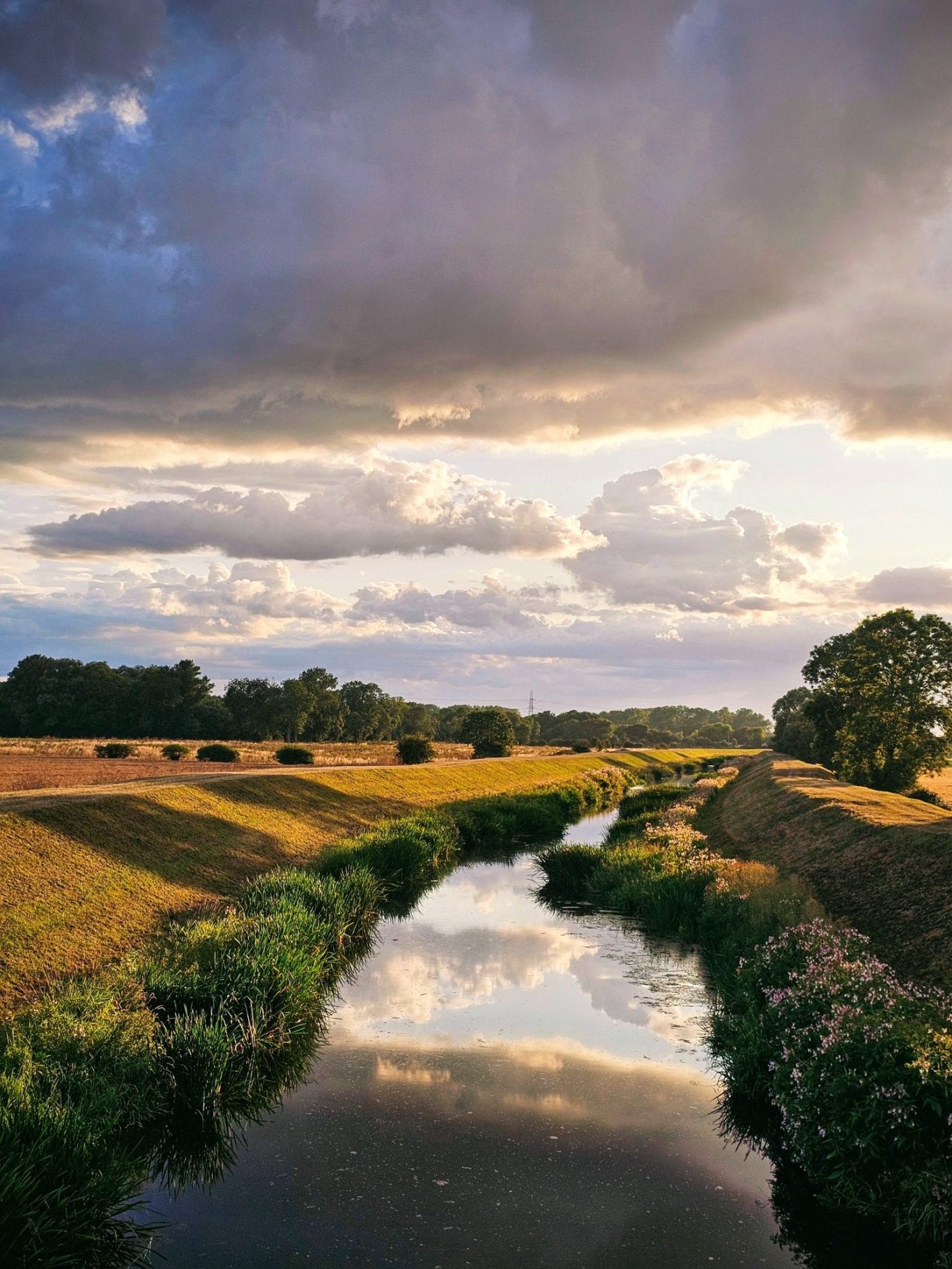
The Welland catchment - Lincolnshire
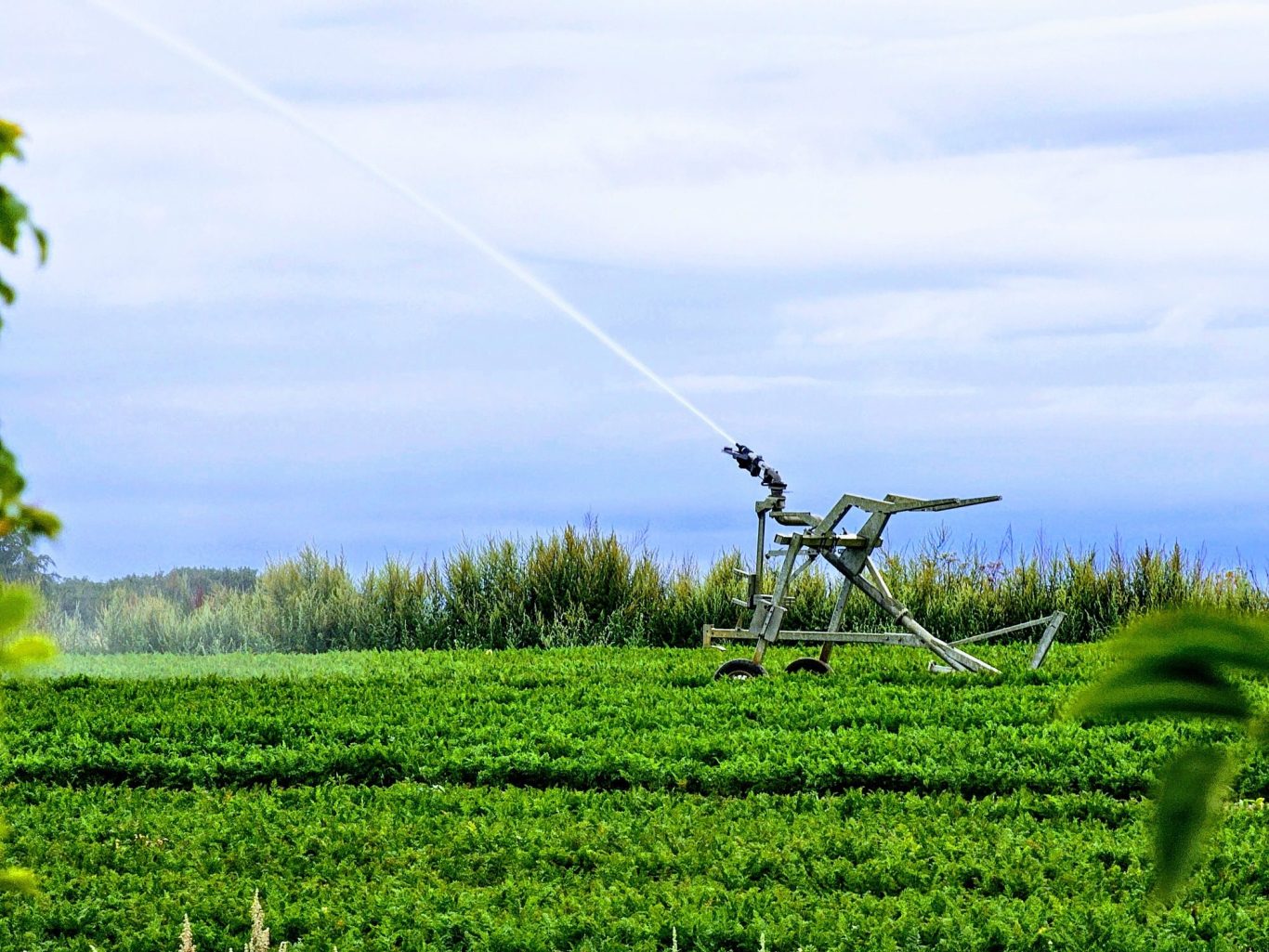
Irrigation of alfalfa in North West Norfolk

Night time irrigation of potatoes in Lincolnshire
Agriculture's voice is heard as drought marches on - 18/7/25
Drought and the threat of it has enveloped most of the UK impacting more farmers and growers across the country.
The Environment Agency (EA) and SEPA are continuing to work to help the sector.
The EA has confirmed that recently announced restrictions will be lifted for approximately 150 of the 240 farmers impacted by a recently announced hands off flow cessation condition in the Cam & Ely Ouse catchments of East Anglia. This followed an urgent meeting between the EA and NFU on Wednesday after farmers in the catchments received notices of cessation from abstraction licences last week.
The NFU has said it will now work to find solutions for members who have not had restrictions lifted. It is also continuing its calls for the EA to work with the farming community to deliver long-term solutions to ensure farmers and growers have guaranteed access to water during dry periods for the sake of national food security.
NFU Vice-president Rachel Hallos said, “We need to ensure that agriculture's voice is heard, and I'm doing my upmost to ensure that is the case. We are pleased to have been able to work collaboratively with the Environment Agency and Internal Drainage Board (IDB) to find a quick solution for some members.
“The scale of the problems we are seeing due to the dry weather on farms on the ground is horrendous. It is costing farm businesses enormous sums of money and some businesses will never be able to recover. This will threaten our national food security.
“This was a huge and very immediate concern for many of our members, who are already having great challenges due to the extreme dry weather we have been experiencing.
“We will work with those members who have not had restrictions lifted and see what solutions can be found for them. There is huge pressure on water in this country. It's about the bigger picture, storing the water when it rains for future use.
The EA confirmed that for a limited number of licences, the hands off flow restrictions will be lifted, with the Internal Drainage Board able to add more water into the system, and new restrictions will be put in place allowing irrigation on Monday, Wednesday and Friday nights only, from 6pm to 6am. This will be on a temporary two-week basis and then reviewed.
A spokesperson for the EA said: "Prolonged dry weather continues to affect East Anglia. Low river levels and dry conditions means we have had to apply temporary abstraction restrictions in the South Level of the Fens.
"These pre-agreed abstraction licence conditions are there to protect the environment and the rights of other abstractors. We are working with the NFU, Internal Drainage Boards, and local farmers to manage water availability."
In Cambridgeshire, Middle Level IDB farmers are reduced to irrigating four nights a week.
Further North, Aden Biddle, Yorkshire Area’s Water Resources Specialist at the Environment Agency said “With rainfall predicted in most areas of ‘The North’ this weekend, the drought incident of 2025 moves onto another important phase. This is when it does rain sporadically and possibly even heavy enough to cause localised surface water flooding but, it in no way ends the drought.
“For the Northern Pennine Reservoirs dry moorland will soak up a lot of the rainfall and it's unlikely that we will see significant refill but it will help river flows for both Public Water Supply and all those agricultural abstractors who have been under "Hands Off Flow" [conditions] for a really long time. Please keep a close eye on the EA's water situation reports.”
For those farmers and growers who use mains water supplies they can view Yorkshire Water’s stocks on its website.
Anglian Water reported this week that the recent rain had helped river and reservoirs levels, delaying the need for restrictions. However, uncertainty over the future forecast meant a hosepipe ban for its customers could still be needed this summer to help support agriculture as well as the environment.
Director of Water Services, Ian Rule said, “We don’t want to put restrictions in place unnecessarily, but protecting the environment and the vital agricultural sector in the region in the face of such unusually dry conditions means leaving as much water in the environment as possible, so we have to strike a careful balance.”
The East of Scotland continues to be the focus of concern for SEPA with eight river catchments remaining at Moderate Scarcity – the Spey, Deveron, Ythan, Don (Aberdeenshire), Dee (Aberdeen), Esk, Firth of Tay and Tyne (Lothian). Rain is expected over the next few days but north east areas remain largely dry.
If conditions do not improve and these areas move to Significant Scarcity, SEPA expect to take action early next week. Measures may include limiting or temporarily suspending abstractions where necessary. SEPA have been in regular contact with licence holders throughout this period and have been working closely with partners including NFUS, Scotch Whisky Association, Scottish Golf and others.
Chris Dailly, SEPA’s Head of Environmental Performance (Geographic), said, “These rivers are approaching critical environmental thresholds following months of sustained low rainfall.
Those who take water from our rivers and lochs have a key role in protecting our environment, and most take that role seriously. Farmers, land managers, food and drink manufacturers and other businesses across the country have been making a real effort. Many distilleries have brought forward summer shutdowns. Irrigators are already adjusting practices. We see that and we value it. But if restrictions are needed they must be implemented and they must be respected.
“This is about protecting rivers and lochs for the long term, ensuring the environment and the businesses that depend on it can thrive. We do not take these decisions lightly. Restrictions will only apply where they are absolutely necessary, and for the shortest possible time. But the evidence is clear, the pressure on the environment is too great in some areas.”
If restrictions are required licence holders will receive written communication from SEPA next week detailing what is required of them. Advice for abstractors is available on SEPA’s website.
The Met Office is forecasting heavy rain and thunderstorms for the UK for much of this weekend into next week with continuing unsettled weather into at least the start of August.
The Met Office’s State of the UK Climate Report 2024 published this week provides a comprehensive analysis of long-term climate trends using data from weather stations. The report confirms a clear warming trend since 1884, with the past three years ranking among the five warmest on record. Earlier springs are likely to be one of the most obvious responses of Nature to the changing climate. The 2024 leaf-on season and the 2024 lawn cutting season were longer than the 1999–2023 baseline, mainly due to the earlier spring.
The Environment Agency has also published its position on nature-based solutions. Nature based solutions include benefits such as increased climate resilience to droughts – by storing water and increasing groundwater recharge. Permits may be required for some nature based solutions including water discharge, abstraction or impoundment and groundwater activities.
Nature Friendly Farming Network has more on how farmers are handling drought and water management. The Growing Voice interview with the CEO of the Nature Friendly Farming Network, Martin Lines, will be published soon.

Irrigation is still significant ahead of a breakdown in the weather this weekend. Some farmers are looking to obtain water from sharing by other irrigators where their sources have physically run out, maximum licensed quantities have been reached or hands off flow conditions are in effect.

Farmers are urged to continue to follow good irrigation practice such as prioritising night-time irrigation, reducing leaks and avoiding windy conditions.
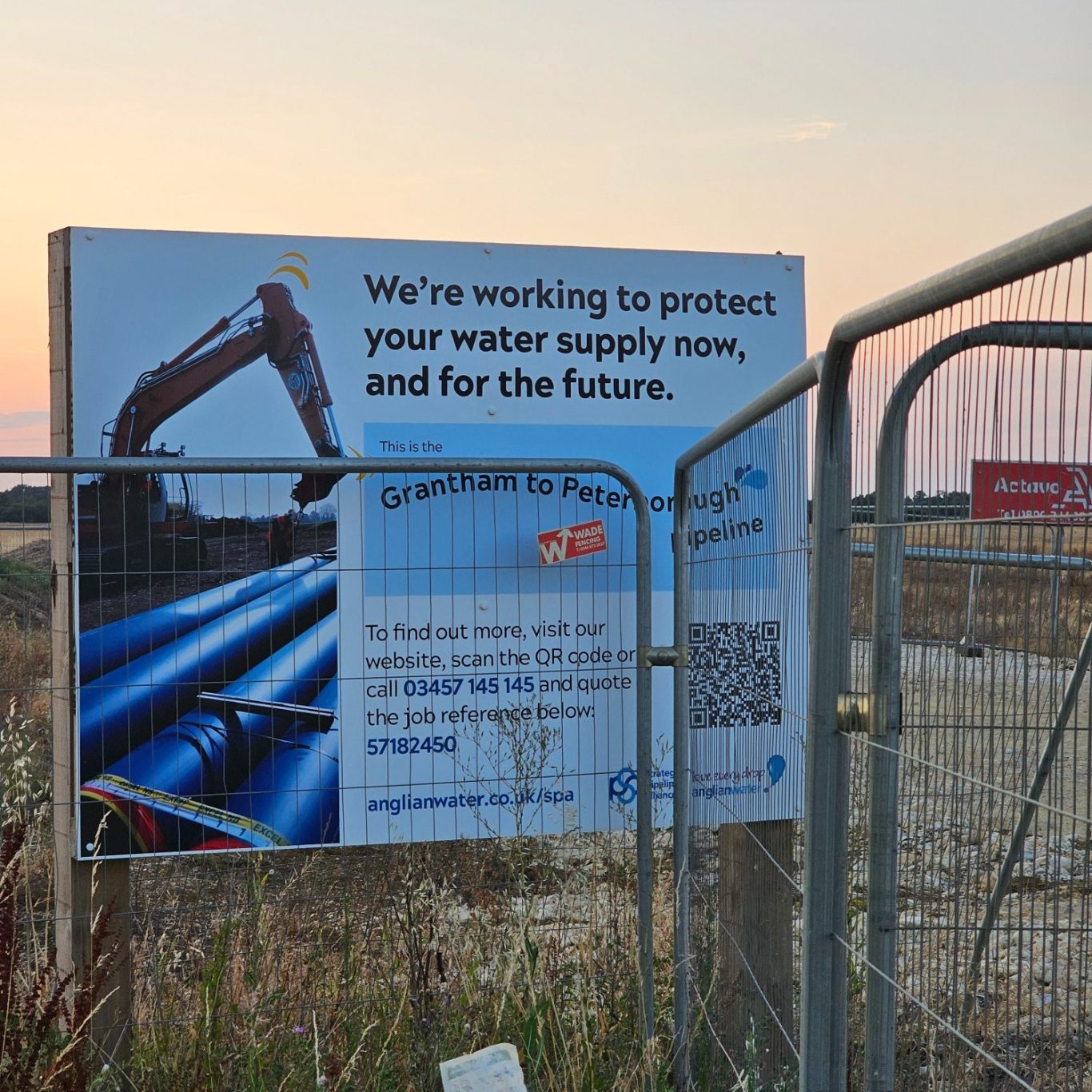
A hosepipe ban for Anglian Water customers could still be needed this summer to help support agriculture.
UK Farmers Face Growing Water Crisis Amid Historic Drought - 11/7/25
With a third summer heatwave affecting the country and media comparisons with 1976, farmers and growers across the UK are sounding the alarm over worsening drought conditions.
Despite recent rainfall the east of Scotland continues to be the focus of concern. The river flows remain very low across much of the east of Scotland. Moderate scarcity remains in the Spey, Deveron, Ythan, Don (Aberdeenshire), Dee (Aberdeen), Esk, Firth of Tay and Tyne (Lothian) river catchments. The Findhorn, Firth of Forth and Almond catchments remain at Alert.
Above-average rainfall is still required for water scarcity levels to recover in the east of the country. The first half of the year in the east of Scotland has been the driest since 1973. These exceptionally dry conditions, following on from a dry autumn and winter last year, have led to the lowest groundwater levels for June on record in Fife and parts of Angus.
Eilidh Johnston, SEPA’s Senior Manager in Water Industry and Rural Economy, said: “We’ve seen how abstractors have responded to the challenge of water scarcity this year and took early action to reduce pressure. However, the risk of required restrictions is not over.
“It won’t take a heat wave to tip rivers into crisis. Sustained low flows and dry soils are already putting pressure on businesses and the environment. We’re asking all abstractors to stay aware of conditions and check the local direct station data regularly especially in the east where pressure is building.
“We’re already in touch with those at highest risk of restrictions, but if you have any questions please get in touch.” SEPA has published more online advice for abstractors.
The Environment Agency has confirmed that the January – June period is the driest start to the year across England since 1976. River flows continue to fall with some north east catchments registering their lowest monthly mean flows on record in June (since the early 1970’s). Groundwater levels continue their typical summer recessions, but most are still within normal or higher levels thanks to good winter recharge. By September, groundwater levels have the greatest chance of being normal or lower across England while river flows are forecast to be below normal at best. The Met Office is forecasting another hot and dry weekend with temperatures building up again late next week.
There is concern within the agriculture sector as more hands off flow conditions on surface water abstraction licences kick in.
The horticulture sector is resorting to emergency measures to water plants with some nurseries tankering in supplies as they run out of stored reserves. Field trees are also being irrigated by bowsers just to keep them alive.
Suffolk farmers are seeing reservoir water volumes significantly reduced (and in some cases completely used up) due to early season irrigation, although many farms have been saved by switching to abstraction from their licensed boreholes. Sugar beet remains unirrigated and second cropping with brassicas is being abandoned with worries over scarce water supplies for plant establishment.
With water supplies running out farmers and growers are making difficult decisions on which crops to irrigate and when. Rodger Hobson, chairman of the British Carrot Growers Association admitted to The Grocer “We’re sort of gambling a bit at the moment. We’ve committed the majority of our water resource to early crops.”
Farmers Weekly has also pushed water resources up the agriculture agenda in Andrew Meredith’s article on food security. “If you want to improve food security, there is no better place to start than with water.”
Water stress impacts on crop development are reported on the AHDB website. Following long dry spells in the spring and recent high temperatures, cereal harvesting is off to the fastest start since at least 2006, with multiple reports of winter barley being cut in June.
The National Trust is recording more drought effects on trees including limb drop. Innovative agroforestry projects are part of the National Trust’s long term plan to plant and establish 20 million trees by 2030 to tackle climate change.
The Environment Agency continues to highlight a range of immediate actions to help farmers and growers. This includes following good irrigation practice and dry weather guidance, contacting them if struggling with abstraction licence conditions and signing up to email alerts to enable taking water as soon as hands off flow conditions allow.
Additional help for the sector is available from the NFU (National Farmers' Union) with its dry weather information and advice page.
The Environment Agency has launched another round of Local Resource Option (LRO) Screening Studies to support groups of farmers in identifying practical, local solutions to help improve their long-term water resilience. The closing date is 20th July, so farmers and growers are encouraged to get their applications in as soon as they can.
Lindsay Hargreaves – Chair of the Lark Abstractors Group was interviewed about abstraction licensing for the agriculture sector on BBC’s Farming Today programme earlier this week. Lindsay highlighted the need to have an abstraction licence and the importance of closely following its conditions (including volumetric limits, recording and submitting data). With constraints on abstraction from hands off flow conditions many farmers are moving to reservoirs to store winter water for summer irrigation. For more information check if you need a licence to abstract water.

River Don in Aberdeenshire still at Moderate Water Scarcity despite recent rain (Photo courtesy of Alison West).
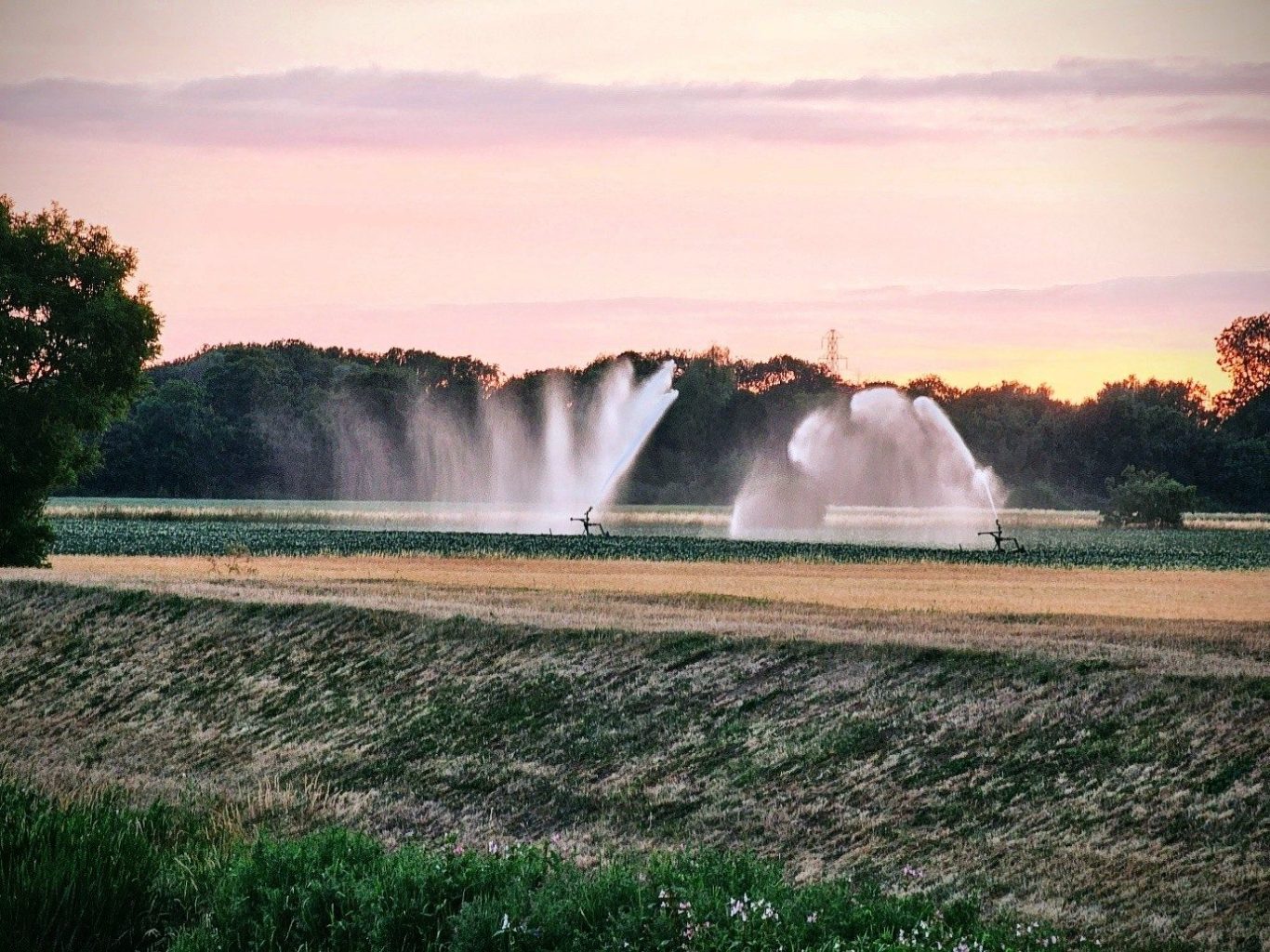
Irrigation under pressure with hands off flow conditions and reservoir water running out

Horticulture resorting to emergency measures such as tankering
As Weather Records Tumble, SEPA and EA Step Up Water Advice to Farmers - 4/7/25
Following the warmest spring on record for the UK and the driest for England since 1893, The Met Office provisional stats for June show that England had its warmest recorded June. Conversely, Scotland experienced cooler conditions as a whole and Orkney registered its wettest June since records began in 1836.
However, SEPA’s latest Water Scarcity Report reveals several rainfall stations in Tayside have now experienced below average monthly rainfall for the last 13 months. Mylnefield near Dundee for example, has only had 58% of its long-term average over the course of the first six months of the year and only 62% over the last 13 months.
Rainfall over the past week has been insufficient to see much recovery across most of Scotland, with ground conditions drying further down the east coast and low river flows persisting. The Spey, Deveron, Ythan, Don (Aberdeenshire), Dee (Aberdeen), Esk, Firth of Tay and Tyne (Lothian) river catchments all remain at Moderate Water Scarcity. Many of these areas have had less than 70% of their average rainfall since the start of the year. As a result, many of the associated river flow stations have had the highest number of days at low flows for the first half of the year on record (spanning almost 100 years in some cases).
In the far north, southeast and southwest however, there has been some improvement in river flows and ground conditions and as a result, the Wick, Helmsdale and Tweed catchments have recovered to Early Warning, and the Cree has recovered to Normal Conditions.
Kenny Boag, Head of Environmental Performance (National) at SEPA said added: "Although there has been relief in the West, most of the East Coast continues to experience water stress. Many catchments remain under significant pressure and the water environment is still in a vulnerable state. More rain is forecast over the next few days, but we need sustained rainfall in the right places over weeks, not just days, to make a real difference.
“We welcome the proactive steps taken by many abstractors, especially in areas of Alert and Moderate scarcity who have already been planning ahead and taking steps to use water efficiently. We urge them to continue to do that as we won’t wait until the situation reaches crisis point to act, and we don’t expect water users to either.
“We will continue to work closely with abstractors and sectors using water from our environment in the areas facing sustained water scarcity. Clear, early communication is being provided so no one is caught off guard. We know how important water is to the Scottish economy, particularly sectors like farming, food and drink, and energy – and we also know that without a healthy water environment those sectors cannot thrive.”
Advice for abstractors is available at: https://beta.sepa.scot/water-scarcity/advice-for-abstractors/
The Environment Agency (EA) in its updated irrigation prospects has already encouraged all irrigators in England to actively review their water needs and consider the range of options to help secure and increase water resilience for the summer.
In East Anglia several catchments have been downgraded to poor where water levels are well below average. Soil moisture deficits have developed early and significant restrictions on abstraction from surface and groundwater are probable. This includes the Old Bedford & Middle Level, North-West Norfolk, Cam & Ely Ouse and the Upper Bedford Ouse.
In England Deputy Director for Water Resources at the Environment Agency, Richard Thompson, had this message for farmers: “Our officers are working with farmers to ensure they have access to water whilst also protecting the environment. I urge farmers to take action now to conserve water as we enter the summer and to use water resources as efficiently as possible.”
Steps include continuing to follow good irrigation practice and dry weather guidance, contacting the EA if struggling with abstraction licence conditions and signing up to email alerts to enable taking water as soon as hands off flow conditions allow. The NFU has echoed this advice calling for strong collaboration between the Environment Agency and farmers during the next few months.
Melvyn Kay, Executive Secretary of the United Kingdom Irrigation Association has a wealth of advice which includes the option of neighbouring irrigators co-operating and sharing water resources where possible. For those using direct irrigation they should be aware of others abstracting upstream and work together to avoid everyone abstracting at the same time.
Looking ahead for the rest of the summer, there seems little respite for farmers requiring water to finish off and lift crops. The Met Office released its three month forecast earlier this week. The chances of hot weather are higher than normal for July-September increasing the likelihood of heatwaves and heat related impacts.

River Don in Aberdeenshire still at Moderate Water Scarcity despite a wetter than average June (Photo courtesy of Alison West).

Night time irrigation of Lincolnshire potatoes

Unirrigated Cambridgeshire field beans struggling in hot and dry conditions
As Scotland’s Water Scarcity Eases, England’s Irrigation Outlook Worsens - 26/6/25
While Scotland has seen easing of water scarcity levels in some catchments, in England farmers face another further decline in irrigation prospects for the remainder of the summer.
Scottish Environment Protection Agency has published its weekly water scarcity report.
"The rain has led to some improvement in river flows in the far north of Scotland. The Naver area has recovered to Early Warning, and the Northwest Highlands and Orkney have recovered to Normal Conditions. But the Wick, Helmsdale, Findhorn, Firth of Forth, Almond and Tweed catchments remain at Alert."
Despite rain, Eastern catchments remain in moderate scarcity: The Spey, Deveron, Ythan, Don (Aberdeenshire), Dee (Aberdeen), Esk, Firth of Tay and Tyne (Lothian).
In England the Environment Agency has published another update to its irrigation prospects reflecting the continued dry weather into June following less than half (44%) of the long term average rainfall over March to May in England. Updated Prospects are here
With many rivers suffering from low flows and reservoir storage depleting in response to high earlier demand for irrigation, this has led to another decline in prospects to moderate across the country, with some catchments in East Anglia ranked as poor.
The Environment Agency is highlighting a range of immediate actions to help farmers and growers. This includes continuing to follow good irrigation practice and dry weather guidance, contacting the EA if struggling with abstraction licence conditions and signing up to email alerts to enable taking water as soon as hands off flow conditions allow. Longer term actions involve considering plans for longer term infrastructure such as reservoirs for future water resilience, applying for a local water resources options screening study and reviewing future cropping plans.
The Met Office is forecasting a low pressure system affecting the northwest of the UK bringing some wetter, windier conditions during the first 10 days of July. Conditions will likely continue to be changeable through much of July.
However, there are very tentative signs of more widely settled weather during the second half of July. Temperatures are expected to be above average for most areas, especially towards the southeast where there will be an ongoing chance of some very warm or hot conditions at times.

Evening Irrigation in Cambridgeshire Fens

Sugar Beet struggling in Hot and Dry Conditions

Maxey Cut Lincolnshire
Scottish Catchments Still in East West Water Scarcity Split - 20/6/25
Scottish Environment Protection Agency has published its latest Water Scarcity Report.
There is still very much an East West split with North East Scotland catchments tending to see the worst of the conditions with Moderate Water Scarcity. The Spey, Deveron, Ythan, Don (Aberdeenshire), Dee (Aberdeen), Esk, Firth of Tay and Tyne (Lothian) all remain at Moderate Water Scarcity.
“Since the weekend, rain has been concentrated in the west, and particularly in the north-west, with little in the east. This rainfall has promoted further recovery in western areas. The Esk (Dumfriesshire), Nith, Dee (Galloway), Irvine and Ayr, Doon and Clyde catchments, as well as Loch Fyne, Kintyre, Loch Shiel and the Outer Hebrides, have recovered from Early Warning to Normal Conditions."
Advice is available here for abstractors and irrigators.
Meanwhile, in England, the Environment Agency will soon be publishing another update to its irrigation prospects. This reflects the continued dry weather into June following less than half (44%) of the long-term average rainfall over March to May across the country. Currently around peak irrigation season many rivers are suffering from low flows with reservoir storage depleting rapidly in response to sustained higher than normal demand.
The Environment Agency continues to highlight a range of immediate actions to help farmers and growers. This includes following good irrigation practice and dry weather guidance, contacting the Environment Agency if struggling with abstraction licence conditions and signing up to email alerts to enable taking water as soon as hands off flow conditions allow.
Additional help for the sector is available from the NFU (National Farmers' Union) with its dry weather information and advice page. Advice is here.
The Met Office is forecasting a north south split in the weather next week “as a series of Atlantic low pressure systems pass largely to the northwest of the UK. Whilst some rain or showers will be possible farther south and east, here longer drier spells are more likely, under the influence of higher pressure.”
Into the first half of July “rather changeable conditions are anticipated … the wettest and windiest conditions most likely towards the northwest with a risk of some heavy rain at times.” But again “Southern and eastern areas are most favoured for longer drier and more settled spells, although even here some occasional rain or showers will be possible, perhaps thundery."

Irrigation Cambridgeshire

Beans Low Yield

Maxey Cut Lincolnshire

Wheat Low Yield
Dry Weather Effects on North East Scotland Agriculture - 10/6/25
The east of Scotland has seen its second driest spring in 100 years and there are some parts of the east coast that have had below average for the last 12 months.
At the recent Open Farm Sunday event organised by Linking Environment and Farming (Leaf), Scott Campbell who owns an arable (cereals and oil seed rape) farm at Kirkton Farm, near Kinellar in Aberdeenshire commented on the water situation.
He said: “Rain is our biggest asset if you can control it. We’ve done a lot of work on our farm making new drains and improving the soil with farmyard manure to add organic matter to the soils. That’s really important in a dry year as soils with a lot of organic matter will look a lot better. Last year was the wettest year we ever saw with a 1000mm of rain between October and March. If you can keep the drainage right and the soil in good health you will get fantastic crops.
“This year has been the complete opposite with the driest spring in 70 years and the crops were suffering more in the drought than they were in the wet. The winter wheat that’s in good soil that has rooted really well shouldn’t be affected too badly. The spring barley that was planted in April it hasn’t tillered, spread out it’s tillers and thrown its roots out because its been so dry. If we lose tillers, we’ll lose plant population and we’ll lose yield. The flag leaf is out already. It normally doesn’t come out until two weeks time, so it could be an early harvest but with less yield. That will be a major concern especially with the malting market dropping in demand too.
As for irrigation Scott says “Potato growers around us do but we wouldn’t invest in irrigation unless we had three consecutive years of drought. Irrigation is for potatoes and high value crops. It’s too much staff and money to purchase the equipment. We haven’t had any grants for that. I don’t think it would fund an awful lot. We need to learn to be on our own two feet and get a good price for our produce. We can’t be holding out our hands to the government. They are carting in water up in Elgin and Speyside when its really dry. I saw irrigators working down in Angus on barley, that’s the first time I’ve heard of that. SEPA is there to help us and work with us and we need to work with them.”
Mike Davis who grows a wheat/oats rotation on his farms in Insch and Oldmeldrum added: “We had an awful year last year as it was so wet. This year it’s been as dry as can be from the beginning of the year. It’s hardly rained and it’s meant that crops went into very good ground really and had a nice seed bed and everything was looking fine. But then it never rained which meant that crops were very slow to germinate established crops like wheat were just about hanging on because of the residual moisture in the ground but were showing signs of struggling. And now the rain’s come it’s actually too late for some crops.
“A lot of spring barley in the North East of Scotland hasn’t tillered and produced secondary shoots. It’s the second tillering that you depend upon to get you the number of heads. If you don’t have the number of heads you won’t get the yield and the result is a very poor crop of spring barley – one of the main crops in the North of Scotland. We have some spring oats which were sown quite early and established itself reasonably well with a bit of a root before the dry weather started to impact.
“Other oats which were sown a fortnight later are really struggling as without the moisture in the ground the plant can’t get the nutrients it needs because all the fertiliser isn’t mobilised. If the plant had a brain the barley would have used it by basically not tillering. Fundamentally the aim of any living organism is to reproduce. The best chance of survival in a year that it didn’t rain is going to be to produce a minimum amount of seed and die. The plant has actually done that and that’s why yields are going to be so poor. The traditional sort of seasons that we had seem to have got blurred into a complete mess. Things are changing”.

Potatoes in Aberdeenshire

Cereals in Aberdeenshire
Scottish Catchments still suffering from Water Scarcity despite rain - 3/6/25
Scottish Environment Protection Agency has published its latest Water Scarcity Report
"The River Helmsdale area has been raised to Significant Water Scarcity. The Wick, Spey, Deveron, Ythan, Don (Aberdeenshire), Dee (Aberdeen), Esk, Firth of Tay and Tyne (Lothian) river catchments remain at Moderate Water Scarcity. The Firth of Forth and Tweed have recovered to Alert. Further recovery means that many of the remaining areas are at Early Warning or Normal Conditions, with some catchments still at Alert.
"If river flows remain very low, the Wick and Thurso catchment will be raised to Significant Scarcity within the next week. Further rain is forecast in the coming week, however well above average rainfall will be required for water scarcity levels to recover after such a prolonged dry period, especially in the parts of the country where rainfall has been limited in the previous weeks.
"The east of Scotland has seen its second driest spring in 100 years and there are some parts of the east coast that have had below average for the last 12 months. “We advise water users, including those with private water supplies, to be aware of the potential risk of water scarcity this summer, and for businesses to plan ahead where possible.” Advice for abstractors and irrigators is available here

Low flows on the River Dee
Reuse of Water for Agriculture - 23/5/25
"We are talking about innovation now. It's really clear we've reached capacity from a water resources perspective in many many catchments. We have a lot of sectors asking for more water, which is a struggle when we are running out".
"More and more, I think the EA are willing to explore the art of the possible in terms of what solutions look like, so it's really pleasing to see examples like this".
Just a couple of comments from discussions following the River Ingol wetland site visit event, near Ingoldisthorpe, West Norfolk.
The treatment wetland was established in 2018 to provide a natural, low-cost and sustainable water treatment method for removing contaminants from the outflow of the local Water Recycling Centre. Although the treated water is not used for agriculture, it does provide an example of what constructed wetlands can achieve in terms of improved water quality. The wetland serves as a good example to consider how to develop this type of water resource as a source for irrigation in the future. The outflow from the wetland is 1Ml/d (1000 cubic metres per day). Some excellent insights from those who designed, constructed and continue to manage the site.
Post visit discussions were led by Huw Richards and George Warren on the application of reused water for agriculture, building on the recent final report on Re-using water for non-potable purposes: a review of opportunities
Potential water reuse in hydrogen production and data centre cooling was highlighted together with the need for wider engagement with other sectors such as golf and race courses, along with the need for appropriate regulation. Water reuse is one of the options that the Environment Agency has explored in its suite of agriculture Local Resource Options Screening Studies.

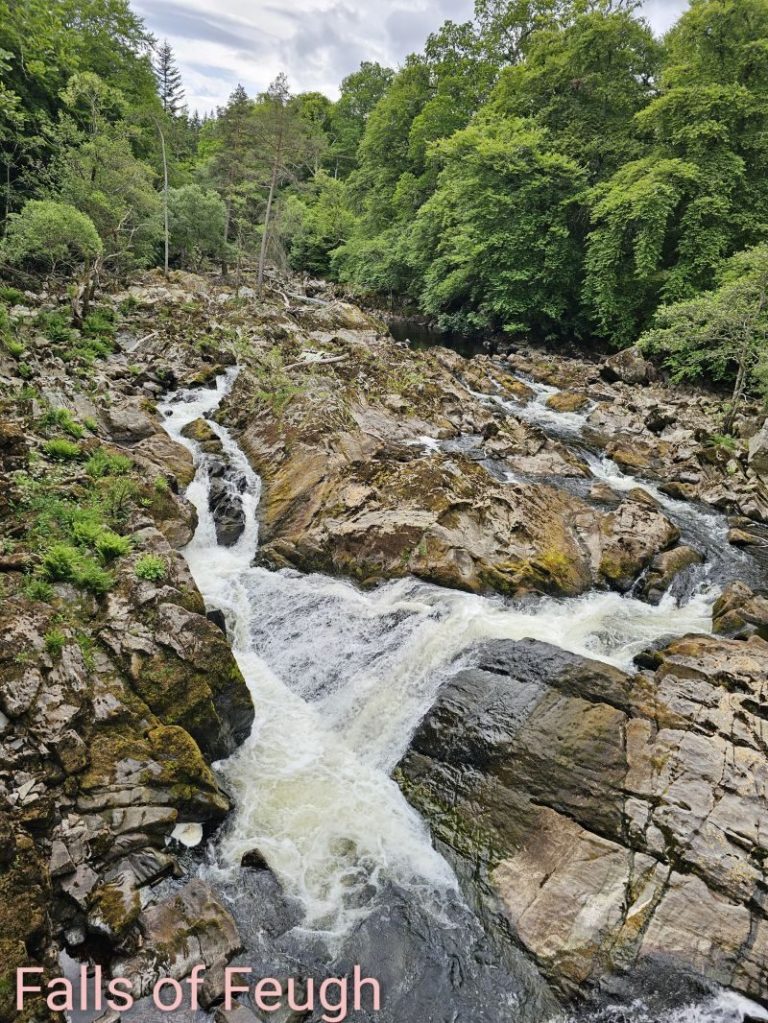
Scottish Catchments at Risk of Significant Water Scarcity - 5/6/25
Scottish Environment Protection Agency has published its latest Water Scarcity Report.
https://beta.sepa.scot/water-scarcity/previous-reports/05-june-2025/
"Further heavy rain over the past week has resulted in some recovery of ground and river conditions, particularly in the west of Scotland.
" However, some areas of the north and northeast are still at risk of reaching significant water scarcity. If river flows in these areas remain very low, the Avon catchment in the Spey, the Lower Dee and Water of Feugh in Aberdeenshire, and the Helmsdale catchment will be raised to Significant Scarcity next week.
"Further rain is forecast in the coming week, however well above average rainfall will be required for water scarcity levels to recover after such a prolonged dry period, especially in the parts of the country where rainfall has been limited in previous weeks. The east of Scotland has seen its second driest spring in 100 years and there are some parts of the east coast that have had below average for the last 12 months."
Advice for abstractors including improving water resilience and contingency planning is available at https://beta.sepa.scot/water-scarcity/advice-for-abstractors/

Off the Grid -4/6/25
Not just an ordinary cup of tea... Greyhope Bay are living the water recycling dream serving up 200 litres of highly treated rainwater harvested hot drinks per day!
https://www.greyhopebay.com/greyhope-stories/sustainability-at-greyhope-bay
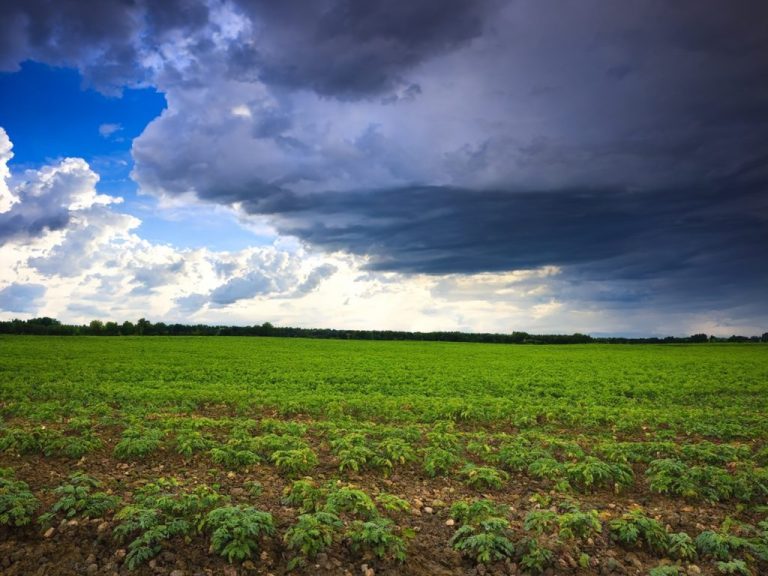
Food Security - 5/6/25
In advance of a key defence review, former senior figures in the UK military are urging the government to broaden its definition of what constitutes “national security” to include food, energy and water security as well as measures to protect communities from flooding, extreme heat and sea level rises.
There are also calls to counter the possible “weaponisation of geoengineering” – hostile actors using geoengineering techniques to manipulate weather patterns to cause extreme conditions.
https://www.theguardian.com/politics/2025/may/29/national-security-definition-food-climate?CMP=share_btn_url
The 2023 paper examined the alarming impacts of malign geoengineering techniques further. :
https://www.sciencedirect.com/science/article/pii/S2211467X22002255#:~:text=Geoengineering%20as%20an%20actual%20weapon,plausible%20%5B19%2C20%5D
It highlighted "conversion of climate technologies into weapons that could affect rainfall, kill off agriculture or affect crops, degrade forests, or interfere with water security."

Whisky & Dry - 28/5/25
Innovative nature based solutions are helping to make the whisky industry (and wider population) more water resilient in the face of current water scarcity and future droughts.
The University of Aberdeen team "demonstrated the benefits of a series of small leaky dams installed in channels to slow water flow by holding the water in that location in temporary mini reservoirs. This allows it to soak into the subsurface so that more water is available at times when it is needed."
" This will help us to assess how resilient different water resources in Speyside are to drought and to understand what causes certain water resources to be more vulnerable whether it is driven by geology, land use or other issues.
“We will then use modelling to help future planning and our understanding of which nature-based solutions might work best where to mitigate water scarcity across the region.”
Dr Mark Wilkinson, from the James Hutton Institute, said: “There is significant interest from diverse stakeholders for these ‘green solutions’ to environmental problems and the project is designed to share insights and to develop a toolkit of options for different environments and users.”
The Environment Agency's Local Resource Options screening studies includes nature based solutions. Hopefully this University of Aberdeen study demonstrates the practical applicability of these types of solutions in suitable catchments.
https://www.abdn.ac.uk/news/24422/

Hot Summer Ahead - 26/5/25
The Met Office are forecasting that the chance of a hot summer is higher than normal:
https://www.metoffice.gov.uk/binaries/content/assets/metofficegovuk/pdf/business/public-sector/civil-contingency/3moutlook-jja-v1.pdf
Meanwhile Global climate predictions show temperatures are expected to remain at or near record levels in the next 5 years
https://www.metoffice.gov.uk/about-us/news-and-media/media-centre/weather-and-climate-news/2025/global-temperatures-expected-to-remain-at-or-near-record-levels
Water minister Emma Hardy said "A situation of rationing, more hosepipe bans, the situation that we see happening in different countries in the Mediterranean. Now, I’m not prepared to let that happen under my watch.”
Hardy is announcing the fast-track construction of two new reservoirs [Fens Reservoir in Cambridgeshire and the Lincolnshire Reservoir], with another seven to come before 2050, after a three-decade period in which none were built. Work has already started on Havant Thicket reservoir in Hampshire.
https://inews.co.uk/news/politics/uk-water-rationing-reservoirs-3719228
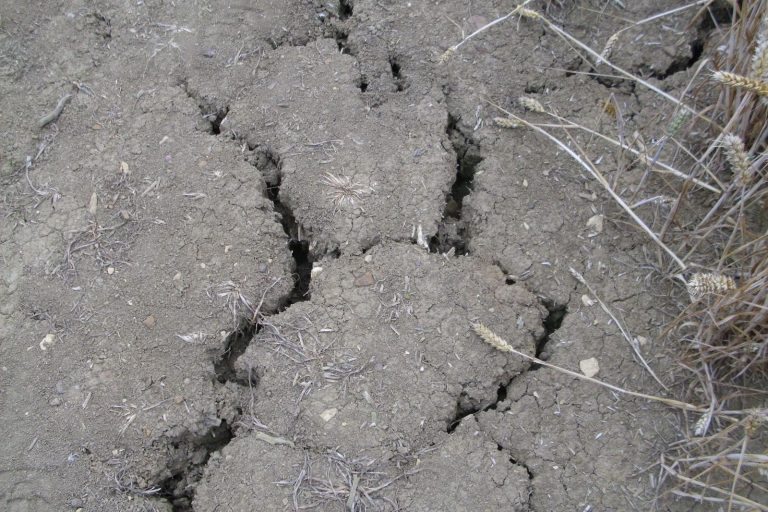
Driest Spring in a Century -22/5/25
‘It’s a critical time’: European farmers struggle through driest spring in a century
Wider European significant dry spring effects being reported on in the Guardian. Extreme weather costs the EU about €28.3bn in lost crops and livestock per year, equal to about 6% of its total food production, with more than half the losses stem from drought.
"Local farmers had responded to the 2018 drought by investing in mechanical tools to extract water from irrigation channels and distribute it over their fields.
In the short term, though, farmers across Europe see little choice but to wait for more rain. Almost a third of the continent was under orange drought warnings by the end of April, according to the European Drought Observatory, with 0.7% in the critical red alert stage."
In response to the continuing dry conditions in England farmers are rapidly using up reservoir storage and abstraction licence volumes in some counties and will be selectively irrigating crops as the summer progresses. Some cereal production is being harvested for anaerobic digestion plants due to poor cropping.
https://www.theguardian.com/environment/2025/may/22/its-a-critical-time-european-farmers-struggle-through-driest-spring-in-a-century
